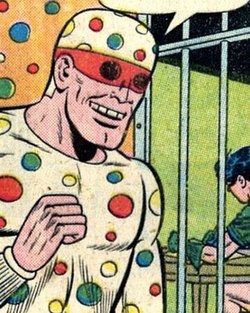Becoming the Polka-Dot Man
Shortly after Batman began appearing in Gotham City, his growing renown inspired an entire generation of costumed rogues who committed largely harmless crimes to attract his attention in the hopes of matching wits with the legendary vigilante. Among these was a local crook named Abner Krill, [2] who decided, for reasons unknown, to launch a crime wave based on spots and dots in Gotham City, where he inevitably came into conflict with Batman and Robin. As Mister Polka-Dot, he wore a costume covered in multipurpose spots. He succeeded in capturing Robin, but Batman defeated him. [3]
Return to villainy
Years later, Krill (now calling himself the Polka-Dot Man) was driven to crime once more when he found himself unemployed, penniless, and desperate to pay his bills. No longer able to afford his original electronically gimmicked costume, he instead resorted to using a baseball bat in a poorly thought-out robbery attempt, which resulted in him assaulting Gotham City Police Department officer Foley. He was then beaten badly by Detective Harvey Bullock, who was sick of costumed villains in the city. The assault put the Polka-Dot Man in traction and he filed a brutality suit against the police department, which resulted in Bullock being forced to see a psychiatrist. [4]
Following his recovery, Krill became a committed alcoholic who spent more time drinking himself into a stupor in My Alibi, a bar known for underworld regulars who vouched for each other's whereabouts when they were off committing crimes, than troubling Batman. [5] The fact that Robin had tracked him down with a leopard became something of a running joke among other villains. [6] As Nightwing, Dick Grayson encountered the Polka-Dot Man a second time when he trashed My Alibi. Nightwing pitched Krill through a window display and into the street, where he was picked up by the police. [7]
In Final Crisis , Polka-Dot Man joins a group of villains working for General Immortus before being killed in battle. [8] [9] He is eventually resurrected following The New 52 and DC Rebirth relaunches. [10]
After his resurrection he seemed to slightly improve his reputation among fellow villains as he was invited to both the villain of the year awards [11] and Maxie Zeus's wedding cruise [12]
He was arrested again at some point after and is shown in a new outfit on a screen of former Suicide Squad members currently imprisoned in Belle Reve. [13]

